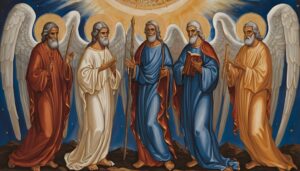The vastness of the cosmos has captivated humanity for millennia, sparking wonder and inspiring countless stories about the divine realm. The Bible, a cornerstone of faith for billions, offers glimpses into this realm, introducing us to a diverse array of celestial beings who serve and worship God. But who are these beings? What roles do they play, and what can their stories teach us about our own place in the universe?
This exploration delves into several key types of celestial beings mentioned in the Bible:
-
Seraphim and Cherubim: First encountered in Isaiah 6, these majestic beings surround God’s throne, their beauty and power echoing the divine presence. Seraphim, meaning “burning ones,” are depicted with six wings and fiery appearances, symbolizing purification and adoration. Cherubim, meaning “guardians,” are often portrayed with wings and multiple faces, symbolizing their role as protectors and watchful beings.
-
Elders: In Revelation 4, a vision unfolds of twenty-four elders seated around God’s throne. They are clothed in white, representing purity and righteousness, and hold golden crowns, signifying authority and honor. While interpretations vary, they are often seen as representing the Church, either its earthly or heavenly manifestation, or even angelic beings associated with wisdom and guidance.
-
Archangels: Among the celestial hierarchy, archangels hold a prominent position. The Bible mentions Michael and Gabriel by name, highlighting their unique roles and significance. Michael, whose name means “who is like God,” is often associated with warfare, protection, and judgment. Gabriel, meaning “God is my strength,” is known as a messenger, delivering crucial messages to figures like Mary in the Annunciation (Luke 1).
-
Four Living Creatures: The enigmatic “four living creatures” appear in Revelation 4, surrounding the throne with an otherworldly presence. Each creature combines the features of a lion, ox, human, and eagle, symbolizing diverse aspects of the creation and God’s dominion over all living things. Their constant praise and worship highlight their role as tireless celestial beings glorifying the divine.
Beyond Categorization:
While these categories provide a framework for understanding, it’s important to remember that the Bible doesn’t offer a definitive taxonomy of celestial beings. Their exact nature and roles remain shrouded in mystery, inviting theological exploration and personal reflection.
Celestial beings, Angels, Seraphim, Cherubim, Elders, Archangels, Four Living Creatures, Bible, Theology, Mystery, Worship, Order, Symbolism, Interpretation, Reflection, Faith, Awe, Wonder, Universe, Cosmos, Art, Interfaith Dialogue
 Jude 1:8 and the Controversy:
Jude 1:8 and the Controversy:
Jude 1:8 mentions “angels who did not keep their proper domain” and “left their own dwelling.” This passage has been interpreted in various ways, with some suggesting it refers to specific celestial beings who rebelled against God. However, the lack of clear identification leaves room for diverse interpretations and avoids placing definitive labels on these unnamed beings.
Significance for Our Lives:
These celestial beings serve as more than mere characters in biblical narratives. Their presence evokes a sense of awe and wonder at the vastness and complexity of the divine realm. They remind us of God’s power and majesty, while also offering glimpses of worship, order, and diverse roles within the celestial sphere.
Open for Exploration:
The study of celestial beings in the Bible is a rich and ongoing conversation. Engaging with diverse interpretations, theological perspectives, and artistic representations can deepen our understanding and appreciation of these intriguing figures.
Remember:
- Open-mindedness: Approaching these topics with an open mind and respect for diverse viewpoints allows for a richer exploration.
- Personal Reflection: Ultimately, the true value lies in reflecting on how these stories resonate with your own faith and understanding of the world.
Further Exploration:
- Delve into biblical commentaries and theological articles offering in-depth analysis of specific celestial beings.
- Explore artistic depictions of these figures throughout history to understand their cultural impact and evolving interpretations.
- Engage in interfaith dialogue with people of different backgrounds to broaden your understanding of these themes and their relevance across various faith traditions.
By embarking on this exploration, we can gain valuable insights into the vastness of the unseen, cultivate a sense of awe and wonder, and deepen our connection with the divine and the universe it encompasses.

